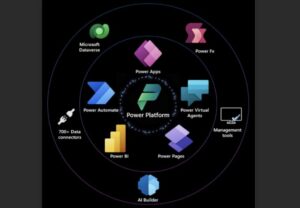
Introduction:
In today’s digital age, businesses need to stay agile and adaptable to meet changing customer demands and market conditions. Power Platform Microsoft offers a suite of low-code tools that can help organizations quickly create custom applications, automate business processes, and gain insights from data. In this blog post, we will provide a detailed overview of the Power Platform Microsoft, its various components, and their capabilities.

What is Power Platform Microsoft?
Power Platform Microsoft is a suite of low-code tools that allow businesses to create custom applications, automate workflows, and gain insights from data. The Power Platform consists of four main components:
Power Apps:
Power Apps is a low-code app development platform that allows users to create custom business applications without the need for extensive coding skills. With Power Apps, businesses can create applications that integrate with other Microsoft products and external data sources. Power Apps supports a wide range of devices and platforms, including iOS, Android, and Windows, making it easy to create apps that can be accessed from anywhere.
Power Automate:
Power Automate (formerly known as Microsoft Flow) is a cloud-based service that allows users to create automated workflows between different applications and services. With Power Automate, businesses can streamline their processes and eliminate manual tasks. Power Automate supports over 300 connectors, including popular services like Salesforce, Dropbox, and Twitter, making it easy to integrate with other systems.
Power BI:
Power BI is a business intelligence tool that allows users to visualize and analyze data from a wide range of sources. With Power BI, businesses can create interactive reports and dashboards to gain insights into their data. Power BI supports a variety of data sources, including Excel, SQL Server, and Salesforce, making it easy to analyze data from multiple sources.
Power Virtual Agents:
Power Virtual Agents is a tool that allows users to create intelligent chatbots without the need for coding. With Power Virtual Agents, businesses can automate customer service and support, and improve customer engagement. Power Virtual Agents supports natural language processing, making it easy for customers to communicate with the chatbot in a conversational manner.
Each component of the Power Platform is designed to work seamlessly with the others, allowing businesses to create end-to-end solutions that meet their specific needs.
Benefits of Power Platform Microsoft:
There are several benefits to using Power Platform Microsoft:
Increased productivity:
Power Platform Microsoft allows businesses to create custom solutions quickly and easily, reducing the need for extensive coding skills and improving productivity. With Power Apps, businesses can create custom applications in a matter of hours, rather than weeks or months.
Streamlined processes:
Power Automate allows businesses to automate repetitive tasks and streamline their processes, reducing the need for manual intervention and improving efficiency. With Power Automate, businesses can create workflows that automatically trigger when specific events occur, such as when a new customer is added to the database.
Better insights:
Power BI allows businesses to gain insights into their data, making it easier to identify trends, patterns, and opportunities for improvement. With Power BI, businesses can create interactive reports and dashboards that provide real-time insights into their data.
Improved customer engagement:
Power Virtual Agents allows businesses to create intelligent chatbots that can provide 24/7 customer support, improving customer engagement and satisfaction. With Power Virtual Agents, businesses can automate routine customer service tasks, freeing up their staff to focus on more complex issues.
Conclusion:
In conclusion, Power Platform Microsoft offers a suite of low-code tools that can help businesses quickly create custom solutions, automate workflows, and gain insights from data. With Power Apps, Power Automate, Power BI, and Power Virtual Agents, businesses can create end-to-end solutions that meet their specific needs. By leveraging the Power Platform, businesses can stay agile by leveraging the Power Platform, businesses can stay agile and adapt to changing market conditions, customer demands, and technological advancements.
The low-code approach of the Power Platform empowers business users to create and modify solutions quickly, reducing the time and cost of development. Additionally, the seamless integration between the Power Platform components and other Microsoft products allows businesses to leverage their existing investments and streamline their operations. Overall, Power Platform Microsoft is a powerful tool that can help businesses stay competitive in today’s fast-paced and ever-changing business environment.
